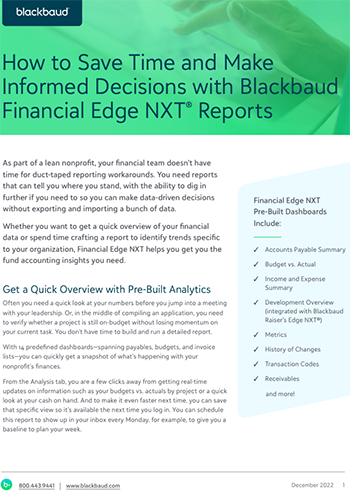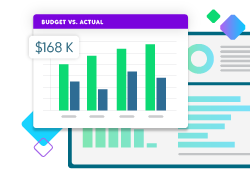The members of your nonprofit’s Board of Directors are many things: knowledgeable and successful in their areas of focus, community leaders, passionate about your mission, and important decision-makers for your organization.
What they might not be are experts in nonprofit finance and management.
For the most effective meetings with productive discussions, you need to present your financial information to your board in a way that they understand, and quickly. Board members are busy, and they may not have time to review the material closely beforehand. By providing clear, organized, and easy-to-understand financial information to your board, you help even your non-accounting members feel confident they are making decisions that benefit the organization now and in the long term.
Here are five ways you can make sure you are communicating your organization’s financial information in a single, efficient story to help your board make effective data-driven decisions.
Be Consistent
With repetition comes understanding. Provide the same reports each meeting, but with timely highlights, callouts, and summary statements to focus on what board members need to know right now. Depending on how often your board meets, you may include snapshots pertinent to this meeting while linking to full yearly reports.
You’ll want to make sure your board has regular access to your Statement of Financial Position and the Statement of Activities. Board members from for-profit businesses may be familiar with the terms Balance Sheet and Income Statement respectively.
You’ll also want to make sure your board is familiar with the status of your Operating Reserve Fund, and your policy around its use. Even if it doesn’t change from meeting to meeting, it’s important for them to understand your overall financial standing. And should an opportunity or issue arise where the fund might be used, the board knows the full picture.
Similarly, all board members should be familiar with the annual audit and IRS form 990 each year. If you don’t want to include them directly in your board book, make them easy to find with a clear link and highlight them verbally a few times a year. These important documents have the board members listed, so they should know what they include and where to find them.
Tell One Story
You have a lot to cover during your time with the board, and only one sliver of the agenda in which to cover it. Lead with the most important information and make it clear what they need to know.
Your fund accounting system has a variety of reports you can use to communicate your financial information. Instead of parading a variety of colorful charts and graphs in front of them, narrow in on the key point you want your board to know or what they need in order to make an informed decision. Understand the story the data is telling and remove the noise.
For example, if you are focused on the increased transportation costs of your mobile clinic and how that could hinder its reach in the summer months, move details about a small increase in food costs out of the graph and into the notes, or into a smaller graph later in the presentation.
When compiling your section of the board packet, tell your board members what they need to know clearly and succinctly. Include headlines in your graphs and clear section headers or keys that make your information easy to follow.
Most importantly, make the story appropriate to the questions and concerns of the board. If you get too far into the details, they will, too, which can take valuable time away from the decisions they need to make. Plus, you don’t want to open the door to micromanagement of your organization’s finances.
Provide Context
Even with the clarity of one narrative, there will be questions. Help your board members understand why the information is important and how it will impact the organization so they can make informed decisions.
Provide details in the board report to clarify any obvious questions or potential confusion. Include a small explanation under any graphs or charts with the main idea, so members reading it after the meeting, or who might be late to the meeting, don’t have to rely on what they think the information means.
Historical context—month over month or year over year—is standard for most reports. But where applicable and helpful, include comparisons that can provide additional context, such as an increase in program income coinciding with a local event, or the change in income diversity after joining a peer-to-peer fundraising platform.
Especially if you are asking your board to make a decision, you might also provide scenarios to illustrate options. Include different budget forecasts based on industry trends you’re watching and other factors that board members should consider as part of their decision-making process.
Be Transparent
Your board cares about your mission almost as much as you do, and understanding the whole financial picture is a key part of how they make decisions. Guide the conversation based on the information the board needs to know, but also provide the full picture so the board members can drill into the specifics if they need to.
Provide access to the full report by adding links to a shared folder or view-only access of dashboards or PDFs pulled directly from your fund accounting system. Make it easy for them to see the raw data and manipulate the graphs with different filters if they want a closer look.
Also be clear about where the data came from. If your fund accounting system is your single source of truth for all your organization’s financial information, you can simply note when the data was pulled or what the report is called so they can find view-only access in the system. If you are pulling industry or demographic data as part of your trends report, be clear where that information came from.
Finally, be transparent about what you need from them. Is this simply information for them to be aware of for future decisions, or do you need them to approve a new initiative? Be clear about what you need from them before jumping into the data so they can review your presentation with those requests in mind.
 Free Resource
Free Resource
Build Actionable Reports
How to Save Time and Make Informed Decisions with FENXT Reports

Give Timely Updates
Whether your board meets monthly, quarterly, or yearly, help your board members stay up to date between meetings by providing some reports or access to dashboards with real-time data.
Set up a cadence for when your board members will receive the packet, such as one week before your quarterly meeting. Work with your organizational leadership to establish an expectation that members should come prepared so you can maximize their time—and yours—during the actual meeting.
Schedule reports to be pulled automatically at specific intervals. You can either email them directly to your board members or provide access to a folder where the reports live. You can also provide view-only dashboards to your board members. The dashboards allow your board members to adjust filters and parameters to look at the data from different angles.
In addition to simplifying the board packet process, providing access to your fund accounting system through automatically pulled reports or dashboards can help you stay ahead of any questions that might arise between meetings.
Train Your Board on Reading Your Report
Even if your board members have a financial background, it’s likely in for-profit businesses. Spend time training your new board members on the reports to help them feel confident in the information they are seeing, so they can bring valuable questions and ideas to the meeting. Make sure they understand your internal controls and their role in those controls.
Offer refresher courses to your veteran members as well, especially if you make a change to the reports, add a new report, or update your internal controls.
Ready to simplify your reporting by having a fund accounting system that streamlines your financial management? Join us for a product tour to see Financial Edge NXT in action.
Fund Accounting Software that Drives Impact
Find out how Blackbaud’s Financial Edge NXT® fits your organization.

The post The Benefits of One Story: Communicating Financial Information to Your Nonprofit Board first appeared on The ENGAGE Blog.


0 Commentaires